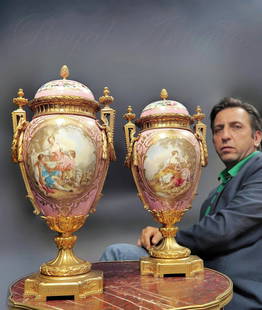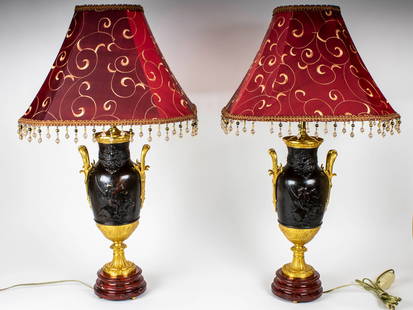
18th C. French Engravings of Ancient Rhytons by William Hamilton
Hamilton Sale History
View Price Results for HamiltonRelated Vases & Vessels
More Items from Hamilton
View MoreRecommended Decorative Objects
View More








Item Details
Description
Europe, France, ca. 18th century. Four large antique engravings of distinct ancient animal rhytons from "Collection of Etruscan, Greek, and Roman antiquities from the cabinet of the Honble. Wm. Hamilton His Britannick Maiesty's envoy extraordinary at the Court of Naples" ("Antiquites etrusques, grecques et romaines tirees du cabinet de M. Hamilton, envoye extraordinaire de S.M. Britannique en Cour de Naples"). Plates, initials, and head- and tailpieces variously engraved by Ant. Cardon, Nolli, Carmine Pignatari, Filip. de Grado, and Dufrenoi, after Giuseppe Bracci, Filip. de Grado, Edmondo Beaulieu, Gio. Bat. Tierce, Aniel. Lamberti, and R. Beaulieu. Sir William Hamilton was a British ambassador to the Kingdom of Naples during the period of Naples' "Golden Age "who was fascinated by the excavations of Pompeii and Herculaneum, as well as an avid collector of classical antiquities, especially Greek vases. Size (sheets): 19.625" L x 15.4" W (49.8 cm x 39.1 cm)
According to rare book seller AbeBooks, "Hamilton's collection of ancient vases, assembled by him after his appointment to the court of Naples in 1764, was first illustrated, described, and published between 1776 and 1777. Pierre Francois Hugues, an authority on ancient art, had introduced Hamilton to the Porcinari family, the owners of a large collection of ancient classical vases which Hamilton bought and enlarged, and then sold to the British Museum in 1772. Before their shipment of England, all the objects were listed, drawn and described under the supervision of the brilliant but unscrupulous baron. The work was finely illustrated with hand-colored engraved plates whose influence on neo-classical design and taste was to be profound (Dictionary of Art). One of the explicit aims of the work was to discover the proportions of ancient vases in order to aid in their true reproduction, and indeed its influence on Josiah Wedgewood was significant. Within barely a year of the publication of the first volume Josiah Wedgwood had opened his pottery works, Etruria, in Staffordshire, and thrown six black basalt first day vases based on vases in Hamiltons publication. Countless other subsequent Wedgwood articles and designs were inspired by the work... In 1772 Hamilton was made a knight of the Bath and elected a fellow of the Society of Antiquaries; he and his wife arrived back in Naples early in 1773, after travelling via Vienna, Venice, Florence, and Rome. Believing that he had exhausted the supply of fine Greek vases, Hamilton did not resume collecting until 1789, when he began amassing what would become his second collection of vases. This collection was fully described in Collection of Engravings from Ancient Vases (4 vols., 1791-95), edited with illustrations by Johann Heinrich Wilhelm Tischbein, director of the Naples art academy. Far less expensive than the Antiquitandeacute's, the volumes of these vase engravings, which were soon republished in various affordable editions, had considerable influence on public taste and on artists such as John Flaxman and Henry Fuseli."
Provenance: private Rancho Mirage, California, USA collection, by inheritance in 2020; ex-Dr. TDR Berreth, California, USA, acquired before 1982
All items legal to buy/sell under U.S. Statute covering cultural patrimony Code 2600, CHAPTER 14, and are guaranteed to be as described or your money back.
A Certificate of Authenticity will accompany all winning bids.
We ship worldwide to most countries and handle all shipping in-house for your convenience.
#179142
According to rare book seller AbeBooks, "Hamilton's collection of ancient vases, assembled by him after his appointment to the court of Naples in 1764, was first illustrated, described, and published between 1776 and 1777. Pierre Francois Hugues, an authority on ancient art, had introduced Hamilton to the Porcinari family, the owners of a large collection of ancient classical vases which Hamilton bought and enlarged, and then sold to the British Museum in 1772. Before their shipment of England, all the objects were listed, drawn and described under the supervision of the brilliant but unscrupulous baron. The work was finely illustrated with hand-colored engraved plates whose influence on neo-classical design and taste was to be profound (Dictionary of Art). One of the explicit aims of the work was to discover the proportions of ancient vases in order to aid in their true reproduction, and indeed its influence on Josiah Wedgewood was significant. Within barely a year of the publication of the first volume Josiah Wedgwood had opened his pottery works, Etruria, in Staffordshire, and thrown six black basalt first day vases based on vases in Hamiltons publication. Countless other subsequent Wedgwood articles and designs were inspired by the work... In 1772 Hamilton was made a knight of the Bath and elected a fellow of the Society of Antiquaries; he and his wife arrived back in Naples early in 1773, after travelling via Vienna, Venice, Florence, and Rome. Believing that he had exhausted the supply of fine Greek vases, Hamilton did not resume collecting until 1789, when he began amassing what would become his second collection of vases. This collection was fully described in Collection of Engravings from Ancient Vases (4 vols., 1791-95), edited with illustrations by Johann Heinrich Wilhelm Tischbein, director of the Naples art academy. Far less expensive than the Antiquitandeacute's, the volumes of these vase engravings, which were soon republished in various affordable editions, had considerable influence on public taste and on artists such as John Flaxman and Henry Fuseli."
Provenance: private Rancho Mirage, California, USA collection, by inheritance in 2020; ex-Dr. TDR Berreth, California, USA, acquired before 1982
All items legal to buy/sell under U.S. Statute covering cultural patrimony Code 2600, CHAPTER 14, and are guaranteed to be as described or your money back.
A Certificate of Authenticity will accompany all winning bids.
We ship worldwide to most countries and handle all shipping in-house for your convenience.
#179142
Condition
Expected age wear with slight toning, areas of foxing, minute losses/tears (most to peripheries), and pinholes to left edge from former binding. Images are still quite vivid. Strong plate marks.
Buyer's Premium
- 26.5%
18th C. French Engravings of Ancient Rhytons by William Hamilton
Estimate $500 - $1,000
3 bidders are watching this item.
Get approved to bid.
Shipping & Pickup Options
Item located in Louisville, CO, usSee Policy for Shipping
Local Pickup Available
Payment
Accepts seamless payments through LiveAuctioneers

TOP






























































![Leah Rhinne Hamilton (1906-1960): Leah Rhinne Hamilton (1906-1960)Two works:Figures by the shoreOil on canvasSigned lower right: Leah Hamilton18" H x 22" W"Tony on the Fourth of July, Downievillor [sic]"Oil on canvasS](https://p1.liveauctioneers.com/255/330641/178336897_1_x.jpg?height=310&quality=70&version=1716473882)



















